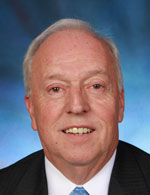As we approach Christmas 2019, most agree that the times are perilous indeed. We live with daily headlines about possible impeachment of the president, about increasing gun violence now targeted at schools and churches, about allegations of sexual abuse committed by people in high-profile walks of life, about genocide in other parts of our world, about the tragedy of human trafficking within our own borders and about the growing persecution of Christians around the globe. So here we are approaching Dec. 25, and the natural question resounds — where is there peace on earth?

Chip Hutcheson
As bad as those are — and they are bad — it looked worse to Henry Wadsworth Longfellow more than a century and a half ago. I was fascinated when I learned the story of the tragedies in Longfellow’s life and how they inspired one of the favorite Christmas carols we sing to this day. Hopefully no matter what your situation is today, the story of his carol will encourage you.
It was Christmas Day 1863 and the country was in the midst of a Civil War — a war he hated. His personal life had more than its share of troubled times when he composed the words to the popular Christmas carol “I Heard the Bells on Christmas Day.” The carol was originally a poem titled “Christmas Bells” and contained seven stanzas. Two stanzas referenced the Civil War, but those were omitted, resulting in the popular carol sung often this time of year.
The story behind Longfellow’s “poem turned carol” is one borne of his own sorrows.
In 1861, Longfellow’s wife, Fannie Elizabeth, died tragically when her dress caught fire. Longfellow, waking from a nap, did his best to put out the flames — first with a rug and then his own body, but she had already suffered severe burns.
She died the next morning (July 10, 1861), and Henry Longfellow’s facial burns were so severe that he was unable to attend her funeral. He grew a beard to hide his burned face — and at times feared that he would be sent to an asylum because of his grief.
In March 1863, Charles Longfellow, the oldest of six children born to Henry and Fannie Elizabeth, joined the Union Army. He was 18, but hid his action from his family.
When he tried to enlist as a private with the 1st Massachusetts Artillery, the battery commander wrote to Henry Longfellow to gain written permission for his son to be a soldier. That request was granted.
“Charley” impressed his fellow soldiers and superiors so much that he was soon granted a commission as a second lieutenant. However, within a few months Charley contracted typhoid fever and was sent home to recover. He rejoined his unit on Aug. 15, 1863, missing the Battle of Gettysburg.
Henry Wadsworth Longfellow was dining at home on Dec. 1, 1863, when he received a telegram saying his son had been severely wounded four days earlier. While involved in a skirmish during a battle of the Mine Run Campaign, Charley was shot through the left shoulder, with the bullet exiting under his right shoulder blade. It had traveled across his back and skimmed his spine. Charley avoided being paralyzed by less than an inch.
Henry Wadsworth Longfellow was informed by the surgeon that his son’s wound “was very serious” and that “paralysis might ensue.” Three surgeons gave a more favorable report, suggesting a recovery that would require him to be “long in healing” at least six months.
So on Christmas day, 1863, Longfellow — a 57-year-old widowed father of six children, the oldest nearly paralyzed as his country fought a war against itself — wrote a poem seeking to capture the turmoil in his own heart and the world around him. He heard the Christmas bells that December day and the singing of “peace on earth” (Luke 2:14), but he observed a world of injustice and violence that seemed to contradict this optimistic outlook.
That’s what led to the saddest words in his poem, reflecting the misery of a man who felt no hope …
And in despair I bowed my head;
“There is no peace on earth,” I said;
“For hate is strong and mocks the song
Of peace on earth, goodwill to men!”
Fortunately the poem doesn’t end there. In his crisis of belief, somehow the Christmas bells that morning remindedhim of a deep truth:
Then pealed the bells more loud and deep:
“God is not dead, nor doth He sleep;
The wrong shall fail, the right prevail,
With peace on earth, goodwill to men!”
The cloud over Longfellow’s life began to lift when he made the decision to focus on the reality that God is alive, that He is sovereign and has a greater plan than we can understand.
We agree with one writer who said, “We will never see the type of ‘peace on earth’ that so many long for. But we can experience peace in our hearts when we put our faith and trust in the God who created the universe … that’s the kind of peace Longfellow finally experienced.”
On that December morning in 1863, Longfellow recognized that “God is not dead, nor doth He sleep.” That statement is just as true today as it was then. And that is why we can all gladly say, “Merry Christmas.”
Chip Hutcheson